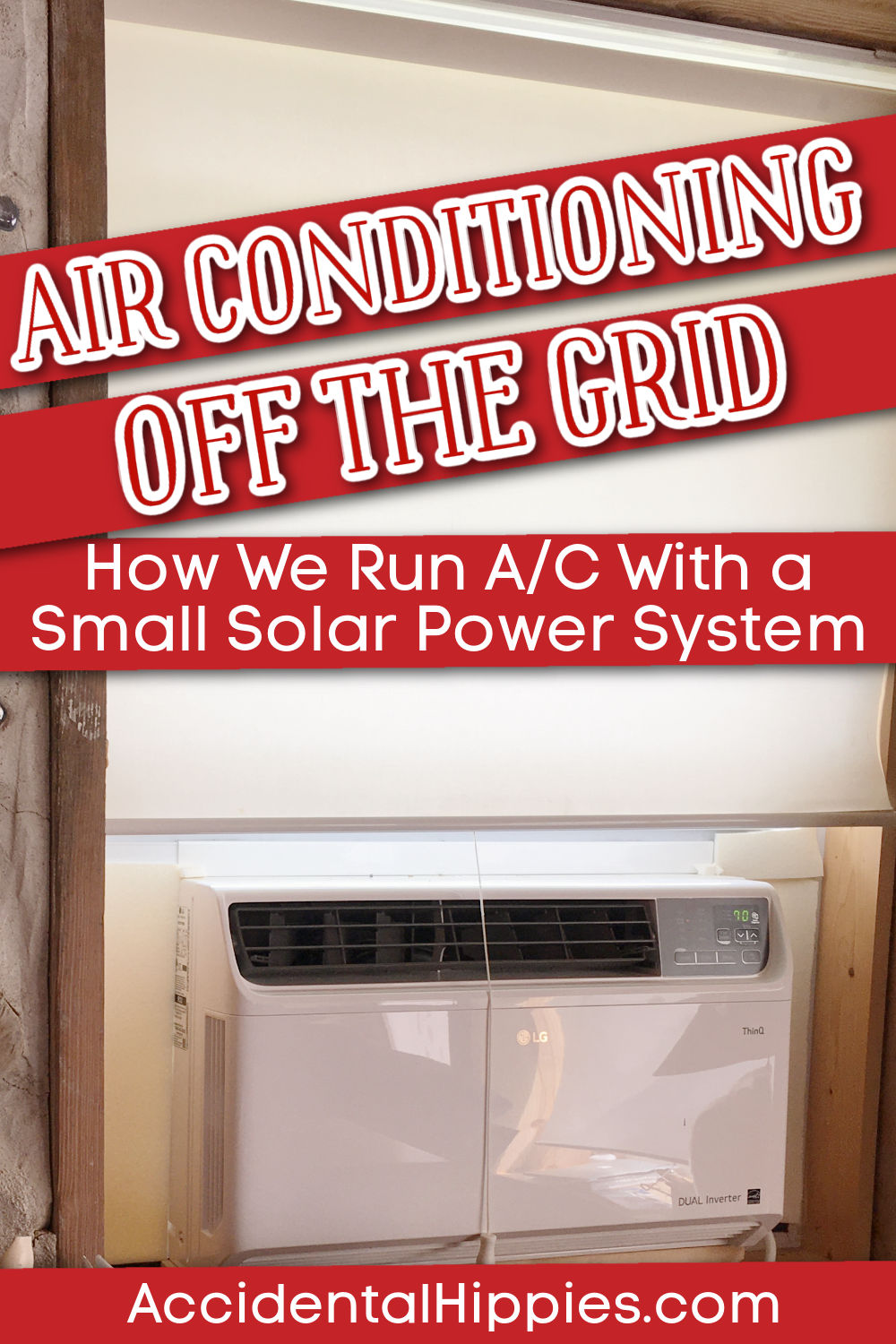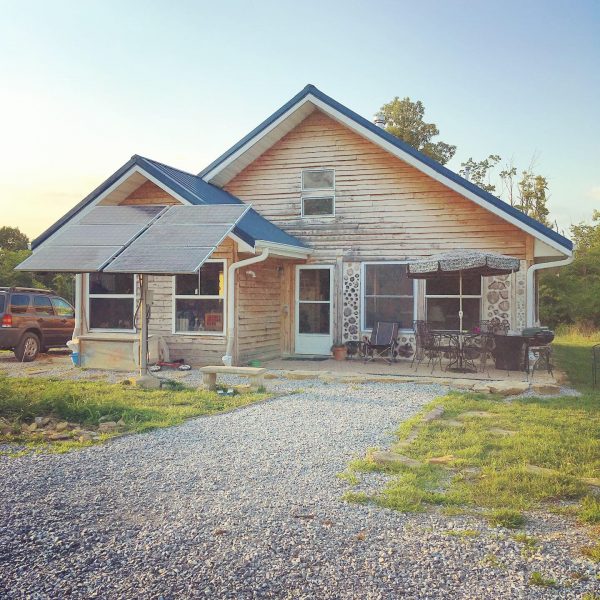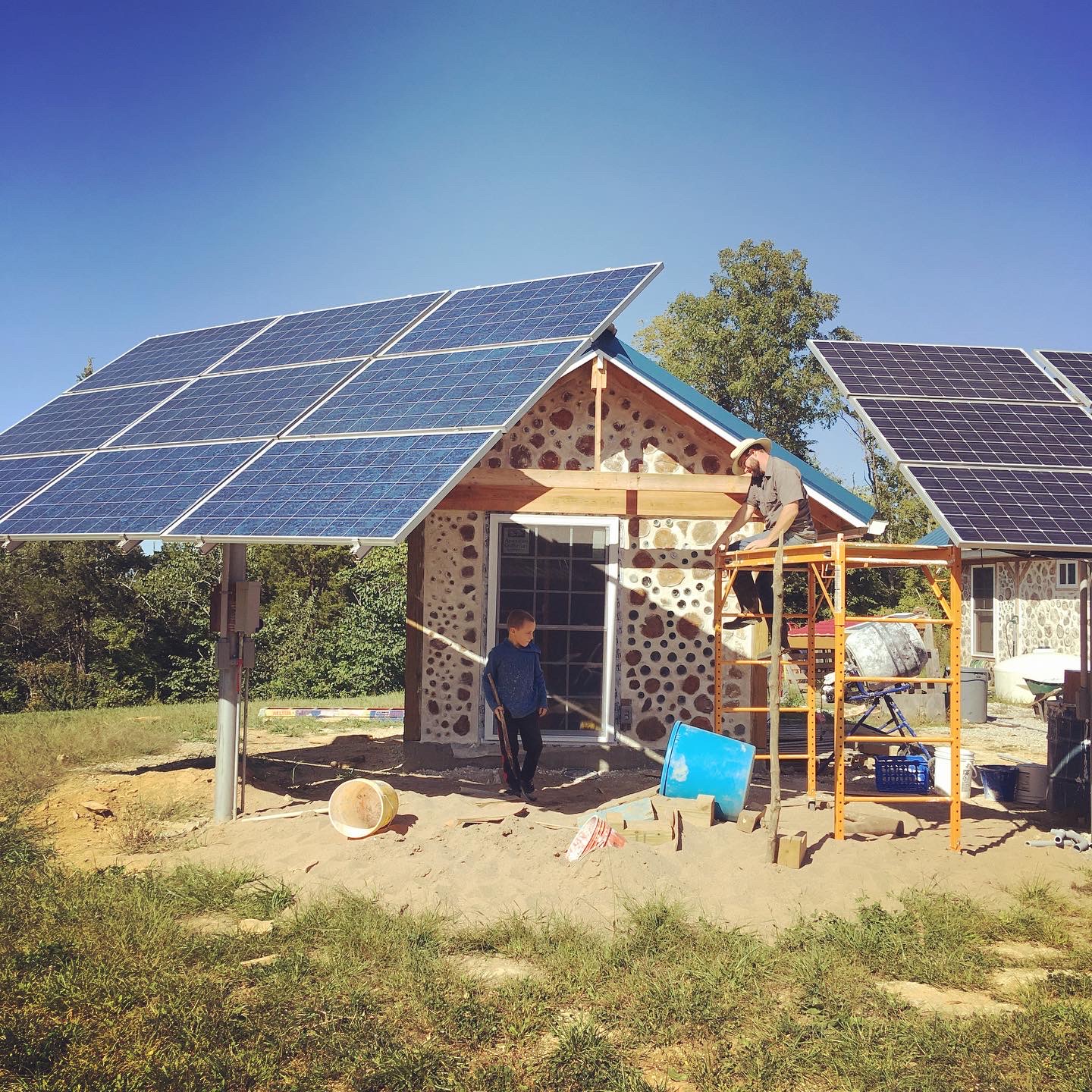Disclosure: I sometimes earn products or commissions from affiliate links or partnerships on my blog. I only recommend products and services I trust to serve you. Learn more.
Our family has been living with off-grid solar power since 2017. When we first started, we had a relatively small solar power system. We could run many things with the system that we had! But there was one problem:
We didn’t have enough power to run air conditioning.
Everything changed last year when we tripled our solar panel capacity. This year for the first time, we have been able to successfully run air conditioning in our off-grid home.
Not just any air conditioner though. In this post, I’m going to walk you through our exact solar setup, why we couldn’t run A/C in the past, the type of air conditioner we purchased, and how we use it with our expanded off-grid power system.

How We Run Air Conditioning With Off-Grid Solar Power
In the days before A/C, our family used a fairly simple method for keeping our house cool. We opened and closed our windows strategically, used fans systematically, and timed everything around the weather and daylight hours. You can read more about that in this post here.
We actually still use all of these strategies to minimize how much we even need to run the air conditioning now that we have it. Here’s the full story:
1. Why We Couldn’t Run A/C on Our Smaller Power System

The original version of our off-grid solar system consisted of the following:
- 6 solar panels capable of producing 1140 watts at peak production
- 1 Morningstar charge controller
- 1 MagnaSine 4000-watt inverter
- 4 UB8D batteries wired to produce 500 amp-hours of power at 24 volts
Simply put, even on the sunniest day those panels could not keep up with feeding the batteries enough power to run a small air conditioner on top of the other things we run on a typical day. Most window units use close to the same number of watts our panels could even produce under optimal conditions.
We weren’t strangers to living without air conditioning, but it got pretty miserable sometimes with long stretches of temperatures above 90-100+ degrees. We also felt pretty bad inviting people over for get-togethers (we typically host a BBQ for the Fourth of July, and our son has a summer birthday). With aging parents especially, we wanted to be able to provide a comfortable, inviting, and safe atmosphere. So we started researching the best ways to expand our system.
2. How We Expanded Our Power System

We added nine more solar panels to our original setup, along with two more charge controllers to have:
- 15 solar panels capable of producing 3,255 watts at peak production
- 1 Morningstar charge controller, wired to the original six panels
- 2 Schneider charge controllers, wired to the nine new panels
- 1 MagnaSine 4000-watt inverter (the same inverter as before)
- 4 UB8D batteries (same as before, but we replaced the original batteries as part of our project)
Related: How We Built Our Cordwood Solar Shed
Being able to produce up to 3,255 watts at a time is a HUGE boost. We have noticed our battery bank is full most days by about noon! That is a huge difference from before, where it might have taken until 4:00 or 5:00 pm to fully charge the batteries even on the longest summer days (if they made it to Float at all).
This effectively means that only about 1/3 of the wattage capacity would be needed for running the air conditioner. Our other power needs are pretty minimal. But before we could go out and buy just any ol’ air conditioner, there were some things we needed to consider.
3. Why a Regular Window A/C Wouldn’t Cut It
If you’re keeping score at home, you’ll notice that we didn’t upgrade our inverter. This means that we’re effectively limited to drawing 4,000 watts of power at a time from our battery bank (we can surge for a VERY SHORT period of time to 5,500 watts). If we attempt to use more than that, the inverter will put itself into a protective shut down and cut power to the house.
We didn’t have the time or resources during this project to replace the inverter. We hope to get a much higher capacity unit and larger battery bank in the future, but we have to work with 4,000 watts for now.
Unfortunately, that means that if the water pump for our cistern happens to hit (about 2,800+ watts startup surge) at the same time as a regular A/C unit with a typical compressor (also about 2,000-3,000+ watts at surge), we’ve already exceeded our inverter’s capacity.
In fact, we got to test this out the year before we upgraded. My mom was getting rid of a small window unit, so we took it in hopes that it might work for us. Normal operating wattage wasn’t too bad — perhaps around 400-500 watts. But when the compressor kicked on it jumped well above 2,500 watts. We tried it alone first. No problems. Then, we tried running the water pump at the same time as the compressor.
The house power cut out immediately.
We knew we needed a different unit AND more panels at a minimum to make this work.
So we got to researching:
4. What to Look For in an Off-Grid Air Conditioner
We knew that the best appliances, in terms of power consumption and efficiency, are “inverter” units. This means that the compressor doesn’t suddenly kick on and off, but will slowly accelerate and decelerate depending on what it needs. This is much more efficient overall (and can save you lots of money on your electric bill if you aren’t off the grid).
It is also much better for ensuring there are no wild start-up power surges potentially cutting power to the house. If you aren’t off the grid, this is a great way to mitigate issues in homes with older wiring and poor circuitry.
We looked at a variety of air conditioner styles. First, we entertained a mini-split unit, like this one.
We didn’t choose this because installing it with our cordwood walls seemed problematic and not worth the fuss. It was also difficult to find an appropriate unit in 120V since our off-grid system isn’t capable of 240V.
So we looked at freestanding units that could potentially move from room to room if needed. I had one of these in a classroom where I taught many years ago, and for that space, it worked nicely. It basically stayed in one spot and vented into the drop ceiling.
LG Freestanding Dual Inverter Air Conditioner
But for our home, a freestanding unit seemed a poor choice. Our venting options are limited to the windows and our minimalist floorspace would make a freestanding unit feel “in the way”. It was also a bit more expensive than we wanted to go.
So instead, we looked at our available windows and ultimately chose this unit:
LG Dual Inverter 14,000 BTU Window Air Conditioner
We purchased this window unit in the spring of 2021 and have used it throughout the entire summer. So far, we really love it! It is super quiet, highly efficient, and has made a world of difference to the “creature comfort” of our home.
If you aren’t off-grid but are still trying to watch your power consumption or avoid tripping breakers in an older home, this unit is fantastically efficient and comfortably quiet.
Ours is 14,000 BTU and can cool around 800 square feet, which is approximately the same size as our home (minus the loft upstairs). After months of using it, I can honestly say that it cools the entire main floor beautifully. The loft is obviously warmer, but it’s still a lot cooler than before we had A/C.
I’ll do a specific product review in a separate post. For now, I want to focus on how we actually USE it with our solar power system.
5. Our Off The Grid Air Conditioning “Routine”

Like I said before, we had a pretty robust method for keeping the house relatively cool without A/C. We have taken that same method and adapted it to make the best of our A/C unit. Here’s what we typically do:
Overnight to morning: We keep our windows open to let the cooler night air in. In our upstairs loft window, we direct a fan outwards to expel the heat. In a downstairs window, just below the upstairs fan on the cooler northeast side of the house, we’ll direct a fan to bring in the cooler night air. Depending on what we need, we might leave the fans on all night. Or we might not. It depends on how much cooler it is outside versus how much we need to bring the inside temperature down.
Morning: We’ll leave the windows open until the outside temperature is roughly the same as the inside. We have this thermometer stationed in the living room so we can monitor the temps. When the inside and outside are the same, we shut every single window and pull the shades down.
Mid-morning to early afternoon: We don’t typically run the A/C during this time. Instead, we prioritize letting the battery bank fully charge and reach Float. Thanks to the thermal mass of our cordwood masonry, along with our earlier cooling strategy, the house is usually pretty comfortable during this time. Most days, it tends to stay between 74-78 degrees Fahrenheit.
Afternoon and early evening: We typically turn the A/C on once the house reaches 77-78 degrees and the batteries are mostly charged. Most days, we might run the A/C from about 12:00 – 8:00 pm, depending on what we need. If we have to go out, we’ll leave the unit on and set its timer just in case we don’t get back before dark.
Evening: We usually turn the A/C off around 8:00, sometimes later when it’s closer to the summer solstice and the days are longer. Between 8:00-9:00 pm, the outside temperatures usually start coming down to meet the inside temperatures. When they are the same, we open the windows back up and turn the fans on.

6. Observations
There are a few things we’ve noticed in the time we’ve had this air conditioner:
First, the voltage of our battery bank at the end of the day when we DON’T run the A/C is usually around 25.6-25.7 volts. On days when we DO run the A/C, it usually settles around 25.3-25.4 volts. This difference doesn’t cause any problems (we always have plenty of power for the night) but it is interesting to note.
Second, If the water pump hits alongside the A/C, there is no problem if the Fan Speed is set to 1. Anything higher than 1 is too much though, and the inverter will usually throw a Fault and cut power at Fan Speed 2 or higher. Getting a higher-capacity inverter in the future will help to solve this issue.
Beyond that, we’ve been delighted with how well this air conditioner has performed to cool our off-grid home.
7. How much power do you need to run A/C off the grid?
The short answer is: at least as much as it takes to run the unit you want at its peak power usage.
The long answer is: it’s complicated. It depends on many variables from what other loads you need to run on the same power system, your budget, and more. I’ll address that in a separate post (soon!) because it requires a bit of nuance.
Learn more!
What We Do (and don’t) Run on a Small 1.14 kW Solar System
How We Built Our Cordwood Solar Shed
What Does It Mean to Live Off The Grid?
Join us for more off-grid goodness!
The easiest way to stay connected, even more than social media, is by joining the email list. It’s the easiest way to guarantee you won’t miss anything new!
Learn more about our original cordwood homestead project here. And be sure to join us on Pinterest, Facebook, and Instagram for more homesteading goodies that don’t necessarily make it to the blog. Thanks for reading!


